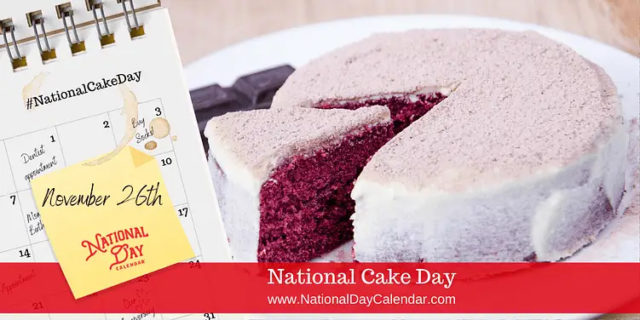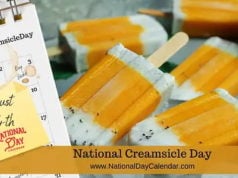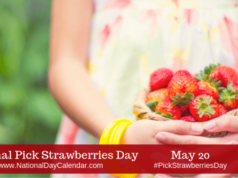
On November 26th, National Cake Day delivers a scrumptious treat for everyone to enjoy! Slide over pie, this day cake takes center stage as the dessert of choice. On most birthdays, the cake is topped with candles no matter their age. Showers, weddings, retirements and anniversaries, cake serves up a slice or two. Add ice cream, and you have America’s top favorite desserts in the same dish!
- The history of cake dates back to ancient times, and the first cakes are thought to have been made in Ancient Greece and Egypt. These first cakes were rather heavy and flat and were eaten at the end of a meal with nuts and honey.
- Nowadays, this type of cake has evolved into baklava, a traditional Greek dessert and a must-try for any fan of sweet stickiness.
- The Oxford English Dictionary traces the English word cake back to the 13th century.
- During the Great Depression, it was necessary to provide easy, relatively cheap food to millions of Americans who were living in poverty, and the boxed cake mix was born.
- The famous saying, ‘let them eat cake’, was attributed to Marie Antoniette upon learning that her people had no bread, but the saying was probably much older.
- The ‘cakewalk’ dance originated in African American communities in the Southern United States and was originally a competition in graceful walking, with cake awarded as a prize.
- The proverb ‘a piece of cake’ was not coined until the 20th century.
- The word ‘cake’ comes from Middle English kake, and is probably a borrowing from Old Norse.
- The meaning of ‘cake’ has changed over time, and the first cake was: A comparatively small flattened sort of bread, round, oval, or otherwise regularly shaped, and usually baked hard on both sides by being turned during the process.
- In Scotland, and parts of Wales and northern England, cake took on the specific meaning of ‘a thick, hard biscuit made from oatmeal’.
- More than 29% of U.S. school districts have banned bake sales due to anti-obesity regulations.
- The saying “You can’t have your cake and eat it”(originally “eat your cake and have it”) is first seen in print in 1562 in John Heywood’s ‘Proverbs and Epigrams.’
- The first birthday cake was originally a cake given as an offering on a person’s birthday. The first reference to ‘birthday cake’ came in 1785.
- During the 17th century, in England, people believed that keeping fruitcakes under the pillow of those who are unmarried will give them sweet dreams about their fiancee.
- Some believe that the tradition of birthday candles began in Ancient Greece, when people brought cakes adorned with lit candles to the temple of Artemis, goddess of the hunt. The candles were lit to make them glow like the moon, a popular symbol associated with Artemis. Others believe that the tradition of birthday candles started with the Germans in 1700s.
- The modern wedding cake as we know it now originated at the wedding of Prince Leopold, Duke of Albany, in 1882; his wedding cake was the first to actually be completely edible. Pillars between cake tiers did not begin to appear until about 20 years later.
- The first mention of the cupcake can be traced as far back as 1796, when a recipe notation of “a light cake to bake in small cups” was written in American Cookery by Amelia Simmons. The earliest
documentation of the term cupcake was in “Seventy-five Receipts for Pastry, Cakes, and Sweetmeats” in 1828 in Eliza Leslie’s Receipts cookbook. - The Red Velvet Cake Recipe was an act of Revenge – One of the interesting cake facts about Red Velvet is that the recipe was made known to the public as an act of revenge. A woman ate the Red Velvet cake in the restaurant and got quite fond of it. She asked the restaurant for the recipe and they charged $100 for the same. She got furious and circulated the recipe widely as a revenge.
- One of the first wedding cakes wasn’t actually cake at all — it was bread. In ancient Rome, bread was broken over the bride’s head to symbolize good fortune and fertility to the couple.
- The groom’s cake has been around since the 17th century. In the 17th century, there were two confections: the bride’s and the groom’s cake. The groom’s cake was usually a fruitcake and symbolized fertility.
- It used to be bridal pie, not wedding cake. The “bride’s pie” (not cake) was served at most weddings up until the early 19th century.
- Cake toppers didn’t become popular until the 1950s, when couples in the US started using them on their wedding cakes.
- during the 17th century, in England, people believed that keeping fruitcakes under the pillow of those who are unmarried will give them sweet dreams about their fiancée.
- Queen Victoria was one of the first to have pure white icing on her wedding cake. That’s why it’s called “royal icing.”
- One of the first wedding cakes wasn’t actually cake at all — it was bread. In ancient Rome, bread was broken over the bride’s head to symbolize good fortune and fertility to the couple.
- Do you know what the middle layer of cake is called? Well, FYI the middle layer cake is covered with frosted cream known as Whoopie pies.
Sources:












